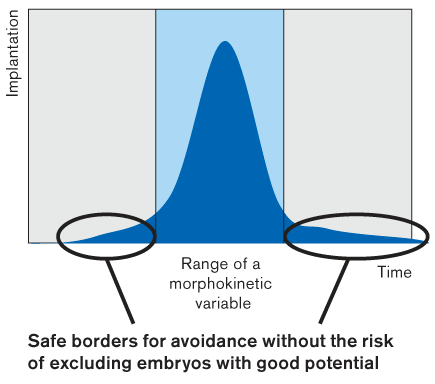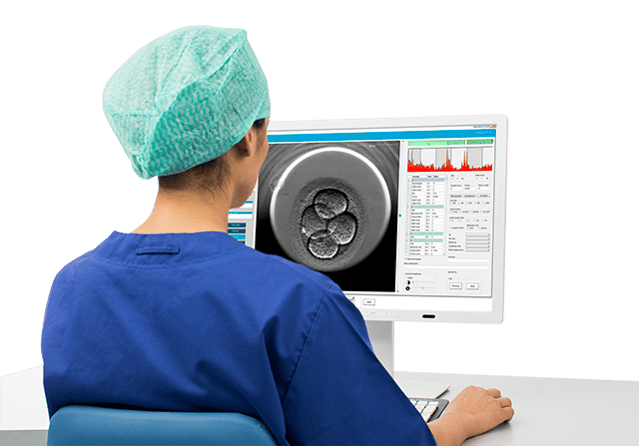Do you recognise the feeling of rush-hours in the lab? Do you find yourself not always being completely sure how to score an embryo because you have to make a fast decision? Time is precious and time is your friend when you are a time-lapse user.
The aspect of time is the essential reason why embryo evaluation with time-lapse has several advantages over static-based evaluation. In this blog post I will highlight why annotation is your key to success.
What are annotations?
In time-lapse, annotations are registrations of embryo development events with a time-stamp on them. This means that every score given to an embryo during assessment has a time-stamp associated with it. Typical parameters for annotation are morphokinetics variables and dynamic morphology variables.
Morphokinetic annotations differ from traditional morphology annotations in that they are registered with the specific time in which a new developmental step happens. This means that they describe developmental progression with a “when did this happen?” assessment contrary to the “did this happen?” assessment of traditional static monitoring methods. This “when” assessment made available by time-lapse monitoring is a precise tool to detect and describe the progression of an embryo during its development.

An example of dynamic morphology trait is the assessment of the number of nuclei in a blastomere. The nuclear status must be considered as a dynamic morphology trait because it is not observable throughout the cellular stage that it belongs to. This means that the time of evaluation for such a parameter is essential and that a non-optimal time for observation may lead to a wrong conclusion about the nuclear status of this cell stage. That’s why morphology features, such as nuclear status, must be observed in a dynamic manner in order to annotate the true value of the variable. This is true not only when looking for multinucleation but also for other morphological traits such as degree of fragmentation, relative size of blastomeres, blastocyst morphology etc. as these are all morphological traits that were proven to have a dynamic behaviour. Again the “when” becomes an important advantage of time-lapse monitoring.
In time-lapse technology an image sequence of embryo development is automatically acquired. Annotations are then done when it is appropriate in the clinic workflow. So annotation is truly a gain with time-lapse technology: it allows complete flexibility for the time of assessment whereas it enables an accurate time-stamp on developmental events.
Why are annotations important?
Registering embryo traits with the specific time of occurrence enables the transition from analogue information to digital information. For embryo evaluation, digital information has the advantage of being more precise and devoid of subjectivity. This sets the basis for consistent evaluation as it is a combination of knowing how to evaluate, when to evaluate and what to decide from your evaluation. Altogether annotations helps you make consistent decisions.
Embryologists are the experts on embryo development. Therefore embryologists are needed to do annotations. Performing annotations requires knowledge about embryology and it needs a critical eye to assess on what is seen and what is not seen in an image sequence. As an example: embryologists know that a blastomere has a nucleus, whereas a fragment, although it may contain some DNA, does not. A trained human eye is needed to distinguish such differences and that's why annotations need to be performed manually from the automatically acquired image sequence.
Is annotation hard work? No. But some preliminary work is required. Before gaining from consistent annotation you need to define a strategy for annotation in your clinic. Such a strategy should contain the variables that should be annotated but also a definition on each variable to ensure that all embryologists are aligned and annotate a variable in the same way. For an efficient daily workflow, variables in your daily annotation strategy should be only those that will be used in your evaluation before you make the decision on which embryo to transfer. For such purposes you can have a strategy that is adapted for different days of transfer.
What are the gains?
The answer is short: Consistent evaluation and therefore clearer decisions.
Thorough selection and deselection of embryos is the overall goal of embryo evaluation and models for such decisions provide a fast and unbiased interpretation of embryo development – but only if the input (the annotations) are consistently performed.
Models for embryo evaluation are built on one or more criteria each based on a variable and an allowed range of values for this specific variable. If we are talking about morphokinetic criteria, the variable will be a developmental step (or a combination of developmental steps). This variable will have an optimal value, specific for your clinic. The allowed range of values will fall within a time frame that includes the optimal values. With such a range each embryo can be considered accurately for each criterion in your model. This is truly the main gain from consistent annotation and digitalisation of embryo developmental information.

An example of a time-lapse variable with a defined optimum which sets the basis for defining an evaluation criteria.
Other gains are an easy workflow and evaluation process. When an annotation strategy is in place there is no doubts about what to annotate and when to annotate it to obtain the information needed for making a decision.
Keep it simple with a strong robust model
Performing annotations is not difficult and is not hard work if you design your annotation strategy in a way that is right for your clinic. Stick to few variables that are sufficient for your evaluation.
Finding out which variables are appropriate for evaluation, however, can be challenging but the basis to get there is consistent annotation. You want your model to be robust, easy to use and helping the selection process.
KIDScore D3 is such a model and it comes with a complete annotation strategy. The annotation strategy for KIDScore D3 tells you exactly which parameters to annotate and how to annotate them and based on this the model assigns a score from 0 to 5 to reflect the implantation potential of each embryo within a cohort.
Read more here if you would like more information about KIDScore
Topics: Time-lapse
Written by Reidun Kuhlmann
Reidun is an embryologist who started using time-lapse in the early days and quickly became completely dedicated. At Vitrolife she trains and supports IVF-professionals in getting the most out of their Vitrolife time-lapse systems, which has taken her many rounds around the globe.

